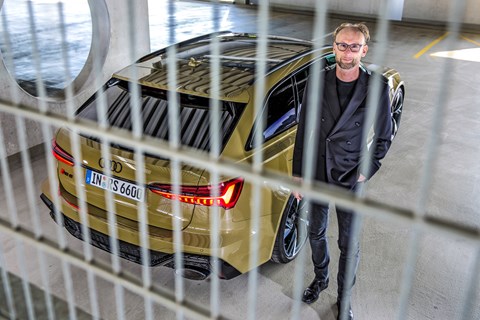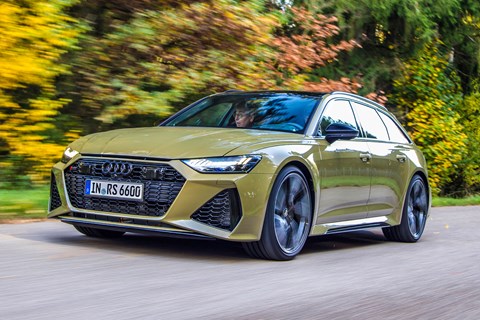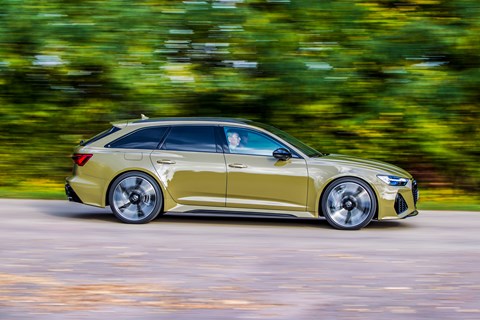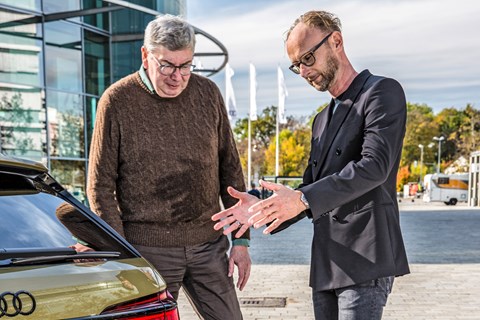► Riding shotgun with Marc Lichte
► ‘Tactical Green’ RS6 is his own
► Georg Kacher gets the guided tour
‘Relax. Like you, I need my driving licence. Trust me, no crazy stuff. At the very most, 20km/h over.’
Famous last words.
We’re in Audi creative director Marc Lichte’s RS6, and he seems very happy to have an excuse to go for a drive. Within the Ingolstadt city limits, a lamb could not be gentler than Lichte. But as soon as we fork off the main drag and head for the kingdom of corners, unbridled excitement releases a dynamic chain reaction.
‘We have more grip now,’ he says, shifting into fourth at an indicated, yowling 101mph before braking hard for a downhill right-hander. ‘Don’t fret, I know the road.’
Our drive of the new Audi RS6 estate
Lichte proves it through a sequence of blind crests and question-mark bends, followed by an eyes-closed single-track section and a freshly tarred stretch of twisties with the grip level of an ice rink. It’s a blast.
This is a very big deal. In so far as you can tell from the passenger seat, the RS6 pulls off the same trick as the RS7 of being an Audi Sport product that stirs the emotions. How? Via the good stuff: consistent interaction, total immersion and inspiring commitment.
Too many RS cars over the years have offered technical riches but slim pickings for fans of dynamic purity. Drive a 2018 model RS5 or RS6 and you’ll likely find the ride and handling sadly lacking in feel and feedback, and the engines muffled and lacklustre.
Enter the new RS7, which fixed most of these faults. And now, fabulously, the RS6 appears to have done the same.
Lichte has created a very special first edition. Seven units have been built and delivered to board members and directors. He tells me: ‘The initial response was so positive that we are going to offer this tailor-made colour and trim combination through the Exclusive division. I actually sold one car myself to a total stranger who walked up to me and told me, “I want mine to look exactly like that”.’

It’s a brutal-looking piece of kit, the extra 40mm in track width, lowered suspension and ground-effect bumpers planting it firmly on the road.
‘To soften this presence, I chose the black pack and refrained from adding any carbonfibre exterior accents,’ says Lichte. ‘This way, it’s only body colour [a striking hue called Tactical Green] and glossy black paint, plus of course a dash of chrome on the bespoke 22-inch wheels. The result is not exactly understated, and yet it is friendly rather than aggressive.’
Describing the interior, he continues: ‘I pushed for even slimmer air vents, but [Ulrich] Hackenberg [Audi’s previous R&D chief] wouldn’t have it. Never mind, cold coffee. Do you like the brushed aluminium trim? I do, but in my office there is already a set of open-pore carbonfibre applications waiting to be installed. Looks and feels even classier.’ Classy like the soft-grain leather trim, an off-black shade with rock-grey stitching.
While talking me through the cockpit, Lichte speed-dials in his favourite Drive Select settings for exhaust, suspension, powertrain, steering, cruise and lighting. Next, the RS1 and RS2 buttons need mapping. In this particular case, stabbing the RS1 button prompts a fairly relaxed waft-home programme, while RS2 is absolutely everything off. ‘Ready?’ Ready!

In the eye of the storm, while I catch my breath, hard-charging Lichte goes on: ‘The RS6 is the only car in this segment you can have with 22-inch rims. The M5 and E63 are restricted to 21-inchers. The extra rubber makes the difference – both in terms of roadholding and street cred.’
Although the aero concept has been developed from scratch, all those spoilers, flaps, splitters and aprons cannot quite neutralise the rear-axle lift, which is rated at 40kg flat out. Power-wise, it’s a dead heat between the previous 597bhp (Performance Pack) RS6 and its 592bhp replacement. On the debit side, mpg increases about 10 per cent due to comprehensive de-smogging equipment. Owing to the mandatory particulate filters, mid-range full-throttle oomph is now at least subjectively somewhat less explosive. According to the data sheet, however, the new RS6 is in tip-top shape.
Despite a 50kg weight increase, the four-seater (the middle rear seat costs extra) can roar from rest to 62mph in 3.6sec and on to 125mph just 8.4sec later. The only truly essential option is the RS Dynamic Package (increasing top speed from 155mph to 174mph), or the Plus version. The latter lifts speed again from 174mph to 190mph, throws in all-wheel steering and adds the sports differential – though Brits get both the bendy steering and slippy diff free. The latter incorporates two wet multi-plate clutches, which distribute the torque between the rear wheels for superior cornering stability and quicker turn-in. Sadly, there is no Focus RS-style drift mode.
To tow his dinghy, Lichte had his car fitted with the optional adaptive air suspension, which can be lowered and raised to hook up a trailer. Having driven the air-sprung RS7 alongside a car boasting the optional RS Sports Suspension Plus with Dynamic Ride Control (DRC), I am inclined to give my vote to the all-steel chassis set-up and lock the adjustable shock absorbers in Auto.
In other Audis, Auto is a neither fish nor fowl calibration, but in the new RS models it combines the best of both worlds: the compliance of Comfort and the tautness of Dynamic. The RS6’s ride is by no means eiderdown plush, but it isn’t torture-bench hard either. As you can imagine, the 22-inch rubber doesn’t help. Instead, the 285/30 footwear crushes the low-speed ride, tramlines like a hare taking to its heels and plays on certain surfaces an even deeper bass than the sports exhaust at low revs in top gear. In second and third, however, with the 4.0-litre V8 revving beyond 4500rpm, this switchable quad-chamber rear-mounted megaphone is loud enough to wake entire colonies of bats from hibernation.
While the latest iteration of the RS6 air suspension is 50 per cent stiffer than in a no-frills A6, the ride in Comfort mode is somewhat cushier than in the same car fitted with the less compliant steel chassis. Another bonus is the air cushion’s ability to lower the body height by 10mm above 75mph and to raise it by 20mm before tackling tall obstacles like a sleeping policeman.

So, no contest? It really depends on individual priorities and preference. The air suspension has the edge in terms of ultimate directional stability, and it offers a relatively broad adjustment range. The largely analogue DRC system is more communicative, more linear and more rewarding when you feel like having a really wild time. In contrast to the previous RS6, which was rather harsh and unrefined when pushed, both versions enjoy much improved composure, suppleness and ground contact. The less erratic low-speed ride over manhole covers and hotch-potch tarmac also deserves a positive mention, as does the near total absence of dive, even under hard braking, and squat under acceleration.
The standard rear-wheel steering usefully reduces the turning circle by a full metre while consolidating the directional stability at speed. You might also want to option the unflagging carbon-ceramic brakes – as much for their constant pedal pressure and travel as their enormous stopping power and immunity to fade.
Lichte assigns full marks again to the reprogrammed electro-mechanical steering. In its latest iteration it’s keen to communicate and immediately addresses any handling frivolities. The dynamic differences between the previous RS6 and the new model are night-and-day drastic. Even excessively ragged turn-in actions are now promptly rewarded with an absolutely reassuring front end, resolute poise and a sublime, admittedly unexpected agility all the way to the (incredibly high) limit. Although traction is rarely an issue, the torque distribution feels now more fluent and more focused, feedback appears more concise and when Lichte wields the whip, velocity and g-force balance each other like friends, not enemies. Depending on the Drive Select set-up and the chosen RS1/RS2 preferences, the car can send up to 70 per cent of the twist action to the front axle, and up to 85 per cent exclusively to the rear.

The V8 produces its peak power output between 6000 and 6250rpm, while maximum torque comes in at 2100rpm. Even though there is virtually no low- to mid-range turbo lag, the work-to-rule throttle response feels a little lazy at times, and the mild hybrid system has no obvious energy saving effect. The compact unit can reclaim up to 16bhp of brake energy, which is then instantly redirected to the buffer battery or used to power the air conditioning and the auxiliary equipment. The more relaxed start-stop system cuts the ignition as soon as the road speed drops below 15mph. At the same time it enables lift-off coasting between 35mph and 100mph, so long as Drive Select has been preset in Efficiency.
But really, that’s incidental to the whole point of the RS6. As Lichte is keen to demonstrate, this is a refined, civilised, sophisticated estate car that’s also capable of mustering more than ample grunt, outstanding performance and reassuring grip. Crucially, it reinstates excitement and emotion as cornerstones of Audi Sport.
Check out our Audi reviews